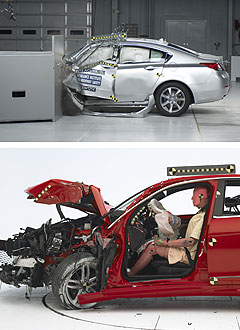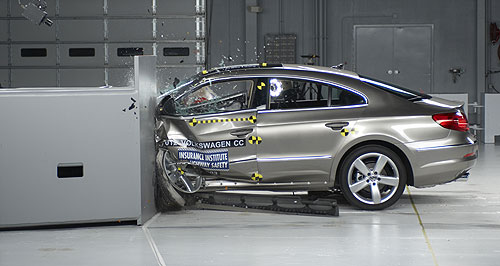Make / Model Search
News - General News - SafetyUS crash test unlikely for AustraliaJust smashing: The Volkswagen CC came off second best in the US Insurance Institute for Highway Safety ‘small overlap’ crash testing. Crash avoidance is ANCAP highest priority, not small overlap crash test15 Aug 2012 A SEVERE new car crash test that has showed up an inadequacy in some otherwise five-star crash safety performers in the United States is unlikely to be replicated in Australia any time soon by the local independent safety watchdog, the Australian New Car Assessment Program (ANCAP). The so-called small overlap test in which just 25 per cent of the vehicle’s front strikes a solid barrier at 40mph (64km/h) has gained worldwide publicity since the US Insurance Institute for Highway Safety (IIHS) announced that only three of 11 prestige cars tested so far had earned a ‘good’ or ‘acceptable’ rating. In one of the tests, the front door of a Volkswagen CC came off, and in another, a Lexus IS crumpled around the legs of the crash test dummy. Highly-rated European cars – the Mercedes C-Class, BMW 3 Series and Audi A4 – that all breezed through Euro NCAP testing were among cars rated either marginal or poor in the IIHS test that is designed to replicate a car crashing into an object such as a parked car, tree or pole, striking just a portion of the front of the vehicle around the headlight. ANCAP chairman Lauchlan McIntosh told GoAuto that a more important priority for his organisation was the adoption of new safety assist anti-collision technologies to avoid such crashes altogether.  From top: Acura TL Mercedes-Benz C-Class. From top: Acura TL Mercedes-Benz C-Class.“I think we have to decide where we put most of our effort and right now these new collision avoidance technologies are more important that this particular test,” he said. Mr McIntosh said another priority for ANCAP was to get some vehicle manufacturers up to speed on current crash tests, including the standard offset deformable barrier test that is used universally around the world by other NCAP regimes. “Our view is that we still have some problems with cars in the offset tests, so we still have quite a lot of work to do in that space,” he said. “We will watch what happens with the (US) tests that they are doing.” The IIHS says US research shows such crashes account for almost a quarter of frontal crashes involving serious or fatal injury to front-seat occupants. But Mr McIntosh said it was unclear if the evidence existed to show that such crashes were a major cause of road trauma in this country. “It don’t think we have enough data in Australia that says that sort of crash is in effect a big priority here in Australia just yet,” he said. Mr McIntosh said the US test would complement the NCAP tests, maintaining the pressure on manufacturers to improve their vehicles. He said one particular crash test by IIHA – on a Ford Lincoln MKZ – showed up a particular problem, with the dummy’s head missing the airbags deployed from both the steering wheel and side roof rail. “The fact that the head missed the airbag is a concern,” he said, adding that research into the frequency of that problem in Australia was needed. “We equally have got to get an idea of what sort of numbers of crashes happen in that sort of way.” In the test, the Lincoln jerked sideways on impact, throwing the dummy’s head towards the A pillar. At the same time, the steering wheel moved sideways towards the middle of the car, creating a gap in the airbag cover, while the curtain airbag was too short to cover the A pillar. According to IIHS, most of the cars tested in the research performed poorly because of a structural weakness in their front extremities. IIHS president Adrian Lund highlighted the structural design of the best-performing car in the tests – the Volvo S60 – which has a rail running from the base of the A pillar towards the front of the car. According to Volvo, the deformable steel rail is designed specifically to cope with such impacts. As well, the S60 has a special crossmember running below the instrument panel to further guard against deformation. The Volvo suffered only a few centimetres of intrusion into the cabin space. “The Lexus IS had ten times as much occupant compartment intrusion as the Volvo,” IIHS said in its media release. “In the IS test, the car’s A-pillar bent and the footwell collapsed as the front left wheel and tyre were forced rearward.” IIHS said that like the Lexus IS, the Mercedes-Benz C-Class also had sufficient deformation to trap the dummy’s feet. The Passat-based VW CC took the dubious honour of becoming the first car tested by the IIHS to lose its door in the test, sheared off at the hinges. The ‘after’ photo of the CC not only shows the missing door but also how the main structural chassis rail was largely undamaged by the crash, with the crash barrier shearing off the front mudguard and front wheel before taking off the door hinges. Under the standard offset barrier test, which impacts 40 per cent of the front of the car, that chassis rail would have taken much of the impact. Apart from the Volvo S60, the only other test car to manage a ‘good’ rating was the Honda Accord-based Acura TL, while the Infiniti G received an ‘acceptable’ rating. Cars rated ‘poor’ were the Acura TSX, the BMW 3 Series, Lincoln MKZ, Volkswagen CC, Mercedes C-Class, Lexus IS250/350, Audi A4 and Lexus ES350.  Read more |
Click to shareGeneral News articlesResearch General News Motor industry news |












Facebook Twitter Instagram